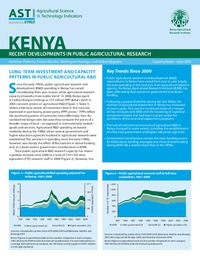Authors:
Flaherty, Kathleen; Murithi, Festus; Mulinge, Wellington; Njuguna, Esther
Year:
2010
Publisher
International Food Policy Research Institute (IFPRI); and Kenya Agricultural Research Institute (KARI)
Back to:
Public agricultural R&D in Kenya continues to be relatively well-funded and staffed compared with many other African countries. In 2008, the country employed over 1,000 FTE agricultural researchers and spent 4.5 billion Kenyan shillings or 154 million dollars on agricultural R&D (both in 2005 constant prices). Following a period of decline during the late 1990s, the number of agricultural R&D staff in Kenya has increased again in recent years. This was the combined result of a merger of two institutes with KARI and the loosening of a general recruitment freeze that had been in place under the conditions of a number of structural adjustment programs. In 2008, total capacity levels were at levels that were slightly higher than those recorded in the early 1990s. KARI remains Kenya’s largest agricultural research agency, although the role of the country’s higher education sector has been on the increase in recent years.
Total agricultural R&D investments in Kenya varied from one year to the next, reflecting fluctuations in donor funding and, to a lesser extent, contributions from the national government to KARI. KARI remains fairly dependent on funding from the World Bank and various other donor agencies, although less so than during the 1990s. The other government agencies are still heavily donor dependent too. In contrast, Kenya’s commodity-based research agencies (KESREF, CRF, and TRF) are almost entirely funded through commodity levies and the sale of goods and services. Although income from the sale of goods and services has increased at KARI and many of the other government agencies since 2001, the share of internally generated resources in total funding in 2008 remained small.
Overall, Kenya outperformed many of its African counterparts in numerous key indicator areas. The country has among the highest research intensity ratios in the region; it continues to attract large sums of donor funding; it has made major improvements when it comes to hiring and training female research staff; and average qualification levels of the country’s agricultural scientists have shown a steady increase in recent years. Despite these positive developments, KARI and the other government agencies face some important challenges on the staffing front. Rapidly increasing numbers of agricultural scientists are approaching retirement age, and staff retention has become a major concern for KARI and the other government agencies as researchers favor better-paid positions at the country’s universities and private sector companies.

